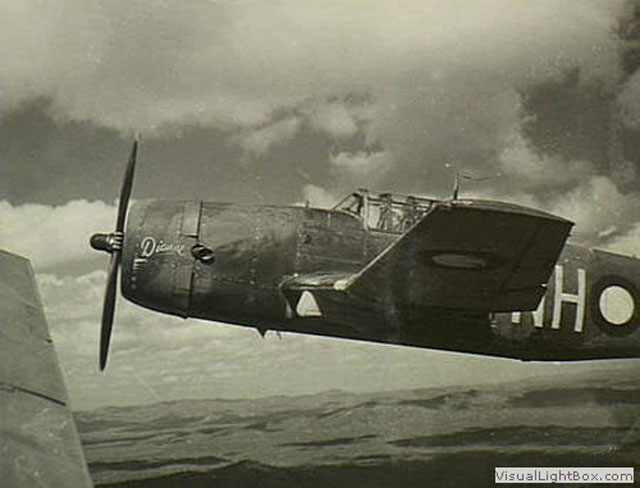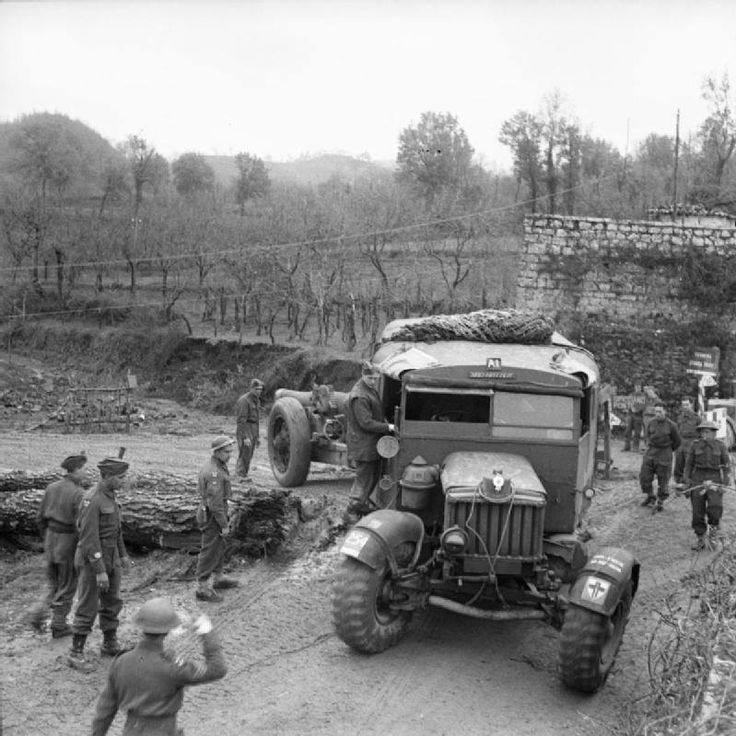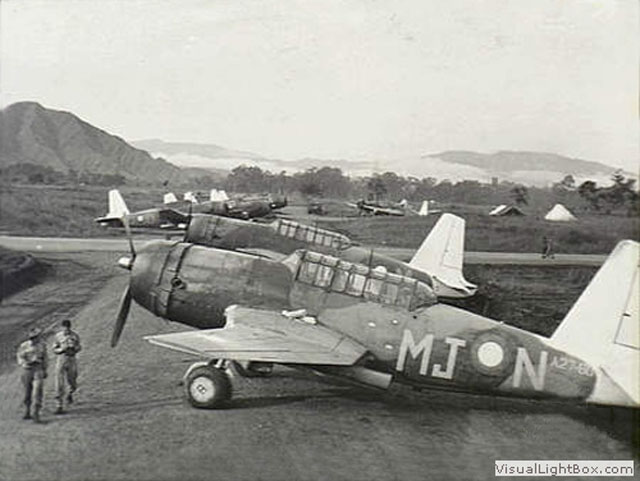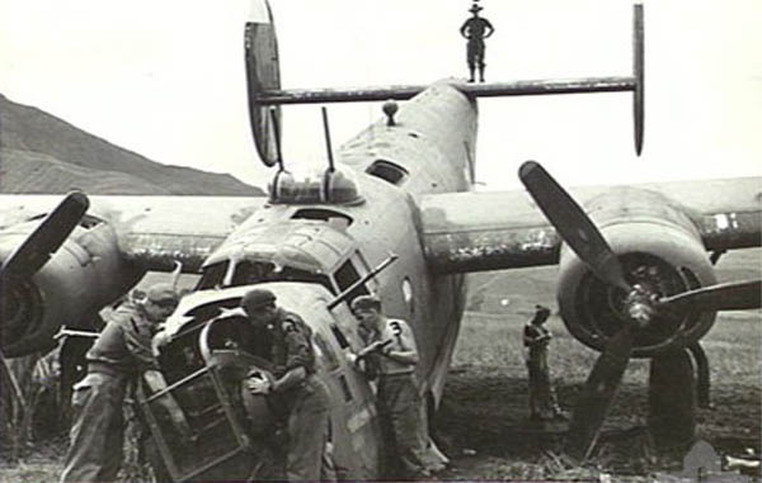Air Operations, Bismarcks
- 61 V Bomber Command B-24s attack Rabaul. V Fighter Command P-39s attack barges in the area between Borgen Bay and Rein Bay while V Fighter Command P-40 fighter-bombers attack Gasmata and strafe Cape Hoskins.
- 18 XIII Bomber Command B-24s, escorted by 48 AirSols fighters, attack the Kervat and Vunakanau airfields at Rabaul with 1,000-pound bombs. US Navy PVs attack a radar station on Cape St. George. A follow-on force of 48 AirSols fighters attacks Japanese fighters returning to the Rabaul-area bases shortly after the B-24s and their escorts have departed the scene.
- VF-33 F6Fs down 3 A6M Zeros over Rabaul at 1305 hours. Marine Corps F4Us down 19 Zeros and Ki-61 'Tony' fighters over and around Rabaul and as far as New Ireland between 1325 and 1410 hours. 18th Fighter Group P-38s down 2 Zeros over Cape St. George between 1355 and 1445 hours. 3 F4Us and 1 F6F are lost.
- It is noted during the AirSols attack that a number of Japanese fighters drop small ďtentacledĒ bombs into the B-24 formation, but with no effect.
- During the night, 394th Heavy Bomb Squadron SB-24s mount harrassment raids against Rabaul. Among items dropped from the heavy bombers are hand grenades and beer bottles.
Air Operations, Central Pacific
VII Bomber Command B-24s passing through Hawkins Field on Betio attack the airfield on Airdrome, which henceforth becomes a practice target for green bomber crews. 1 B-24 is lost.
[Air Operations, CBI
CHINA- 29 308th Heavy Bomb Group B-24s attack the White Cloud airfield at Canton. 2 11th Medium Bomb Squadron B-25s attack a Japanese Navy gunboat in the Formosa Strait. 14 449th Fighter Squadron P-38s dive-bomb Huang Shan Kou.
- P-40s from the 23d Fighter Groupís 74th and 76th Fighter squadrons, the 51st Fighter Groupís 16th Fighter Squadron, and the 3d CACW Fighter Groupís 32d CACW Fighter Squadron down 6 A6M Zeros and Ki-44 'Tojo' fighters over Canton at 1400 hours.
- During the night, 19 7th Heavy Bomb Group B-24s attack rail facilities at Bangkok.
Air Operations, Europe
RAF BOMBER COMMANDBattle of Berlin
- 390 aircraft including 375 Lancasters, 8 Mosquitoes and 7 Halifaxes, are sent to Berlin. The time over the target is 3:58-4:12. 1,265 tons of bombs are dropped which include 697 tons of high explosives and 568 tons of incendiaries. 42 aircraft are involved in other operations.
- The outward flight is to be a long southerly approach hoping the Germans will think it is a repeat raid on Frankfurt. Since a smaller number of Lancasters are available the total tonnage of bombs dropped on the target, 1,265 tons, is the lowest since The Battle of Berlin was resumed. Because of worsening weather the takeoff is postponed from late afternoon until about 7 hours later which would have the bombers return in daylight. Bad weather over the German fighter airfields and icing conditions throught the clouds reduces their efforts. The Bombers arrive over Berlin under favorable condisions - no fighters and few searchlights. There are 39 Blind Markers on this raid and they all make it to Berlin. Only 11 release their markers, however, because of either H2S set problems or problems with the German defenses. Only 1 aircraft drops target indicators and this is 6 miles to the south of the Aiming Point. There is no damage reported in the main built-up areas of Berlin. German records show that some bombs fall in the southern and eastern districts of the city, but many fall in the open areas of the suburbs. 178 people are killed and about 600 are bombed out of their homes. Night fighters claim only 11 successes at a cost of 6 of their own.
- 15 Lancasters are lost on the raid with aircrew casualties being 104 killed and 16 POWs. 1 Servale Beaufighter is lost.
NETHERLANDS:
- 353rd Fighter Group P-47s dive-bomb the Gilze-Rijen Airdrome.
FRANCE:
- 15th Air Force B-26s attack the Antheor viaduct.
- 15th Air Force B-26s attack a marshalling yard and rail bridge at Imperia, and various targets around Ventimiglia.
Air Operations, Marshalls
- P-39s of the 318th Fighter Groupís 72d Fighter Squadron down 2 A6M Zeros over the Mille Atoll at 0910 hours.
- 19 VII Bomber Command B-24s based at Nanomea pass hrough Hawkins Field on Betio to attack the Kwajalein Atoll. 9 B-24s based at Nanomea pass through the airfields on Baker Island and Canton Island to attack the Maloelap and Wotje atolls. 10 531st Fighter-Bomber Squadron A-24s and 20 318th Fighter Group P-39s based at Starmann Field on Butaritari attack the Mille Atoll.
Air Operations, New Guinea
- V Bomber Command B-24s attack Nabire. More than 80 V Bomber Command B-25s, B-26s, and A-20s attack the airfield at Alexishafen, targets on the Huon Peninsula, and coastal targets between Hansa Bay and Wewak.
- A V Fighter Command P-47 downs a Ki-61 'Tony' fighter over the airfield at Dagua at 1045 hours.
Air Operations, Solomons
- 17 42nd Medium Bomb Group B-25s attack Sohano Island, 6 B-25s attack coastal targets on Choiseul, and 16 XIII Fighter Command P-39s attack targets in the Shortland Islands.
- During the night, 394th Heavy Bomb Squadron SB-24s mount individual harrassment attacks against Buka, Faisi, and Kieta.
Algeria
Gen Jean-Marie de Lattre de Tassigny arrives in Algiers after escaping from Riom prison and being flown to Britain. He was imprisoned by the Nazis after protesting violations of the armistice terms in the unoccupied territories of France. De Lattre takes command of the French 1st Army when he arrives in Algeria.
[Eastern Front
SOUTHERN SECTORWith the fighting at Meleni increasingly intense, the XLVIII Panzer calls off its attack. The unexpected German assault has succeeded in severely mauling 4 Soviet corps that had been assembled for the next phase of the offensive in the Ukraine, disrupting the Soviet plans slightly.
Even so, the 1st Ukrainian Front is poised to attack the northern wing of Army Group South once again, the Stavka aiming to turn the left flank of the German southern wing and encircling what is left of it before the Dniestr River. The plan calls for the 1st and 2nd Ukrainian Fronts to drive through the 4th Panzer and 8th Armies and reach Mogilev-Podolsky and Pervomaisk while the 3rd and 4th Ukrainian Fronts attack on the lower Dniepr, between Nikopol and Krivoi Rog.
For the offensive the Stavka has assembled a force of 2,365,000 men. The 1st Ukrainian has 924,000 ment, the 2nd, 594,000, the 3rd, 337,000 and the 4th, 550,000. All 4 fronts combined include more than 2,000 tanks and Su's, 29,000 arty pieces and 2,360 aircraft in support. Of this number, virtually the entire tank strength is operational and half the infantry are in the combat line. To face this massive force Manstein's Army Group South has 43 infantry, 15 panzer and 7 panzer grenadier divisions, which when combined with Kleist's Army Group A total 1,760,000 men. To support the infantry the army groups have 2,200 panzers and assault guns, barely a third of which are fit for action, and 16,000 arty pieces. Army Groups South and A have 1,400 aircraft on hand to provide aerial support but again many are out of action due to repairs or lack of fuel. In the Crimea and along the southern ben of the Dniepr are the 17th and 6th Armies of Army Group A. The weak Rumanian 3rd Army is also in the Crimea. Army Group A has 8 German infantry divisions, 10 Rumanian divisions and 1 field training division.
The fighting in the autumn of 1943 had proved to be a long string of setbacks for the Ostheer. Forced back across the Dniepr and from Kiev, the German southern wing has been pushed back upon itself. Hitler's insistence that every yard of territory be retained had proved a weight around the German commanders' necks. For the Soviet generals it had been a time to master their art, tank armies and rifle forces learning to operated n conjunction with their resurgent air forces. The renewed Soviet offensive in the Ukraine, and offensives of 1944, would prove the Soviet mastery of the concept of battles of annihilation.
The hard fought battles along the line of the Dniepr had established the Red Army in the Western Ukraine, a position confirmed by the capture of Kiev. There now began a series of operations on the southern wing that would bend the German front back to the Rumanian border and lay the foundations for the defeat of Army Group Center in the summer of 1944.[
Baltic Sea
U-345 is damaged beyond repair in a USAAf daylight raid on Kiel.
| Class | Type VIIC |
| CO | Oberleutnant zur See Ulrich Knackfuss |
| Location | Baltic, Kiel |
| Cause | Air attack |
| Casualties | Unknown |
| Survivors | Unknown |
CBI
BURMAThe 3rd Battalion of the 114th Regiment, Chinese 38th Division, having crossed the Tanai at Kantau earlier in the month begins operations in the Hukawng Valley in Burma as they skirmish with the enemy 9 miles from Kantau.
[Italy
The 1st Canadian Div from 8th Army seizes control of most of Ortona. Inland, the British 5th Div takes Arielli, north of Orsogna.
[Pacific
- The US submarine Corvina (SS-226) is reported as presumed lost in the Pacific Ocean area.
- The Japanese submarine I-39 is sunk by the US destroyer escort Griswold (DE-7) in the Solomon Islands area.
Images from December 23, 1943
|
|
|
|
|
|





